Comprehensive Report on the Effects of Cardiovascular Diseases
VerifiedAdded on 2023/01/23
|7
|1820
|89
Report
AI Summary
This report examines the multifaceted effects of cardiovascular diseases (CVDs) on global health, drawing upon various studies and reports. It highlights CVDs as a leading cause of death, emphasizing the significance of behavioral risk factors like obesity, smoking, and unhealthy diets. The report delves into the different types of CVDs, including coronary heart disease and stroke, and their impact on both developed and developing nations. It analyzes mortality rates, risk factors such as hypertension and genetic predisposition, and the economic burden associated with CVDs. The report also discusses prevention strategies, including quitting smoking, adopting healthy dietary habits, and regular exercise, to mitigate the impact of CVDs and improve public health outcomes. The study underscores the importance of addressing CVDs through comprehensive strategies to reduce its global impact.

Student name
Student No
Unit
Title: Effects of Cardiovascular Diseases
Student No
Unit
Title: Effects of Cardiovascular Diseases
Paraphrase This Document
Need a fresh take? Get an instant paraphrase of this document with our AI Paraphraser
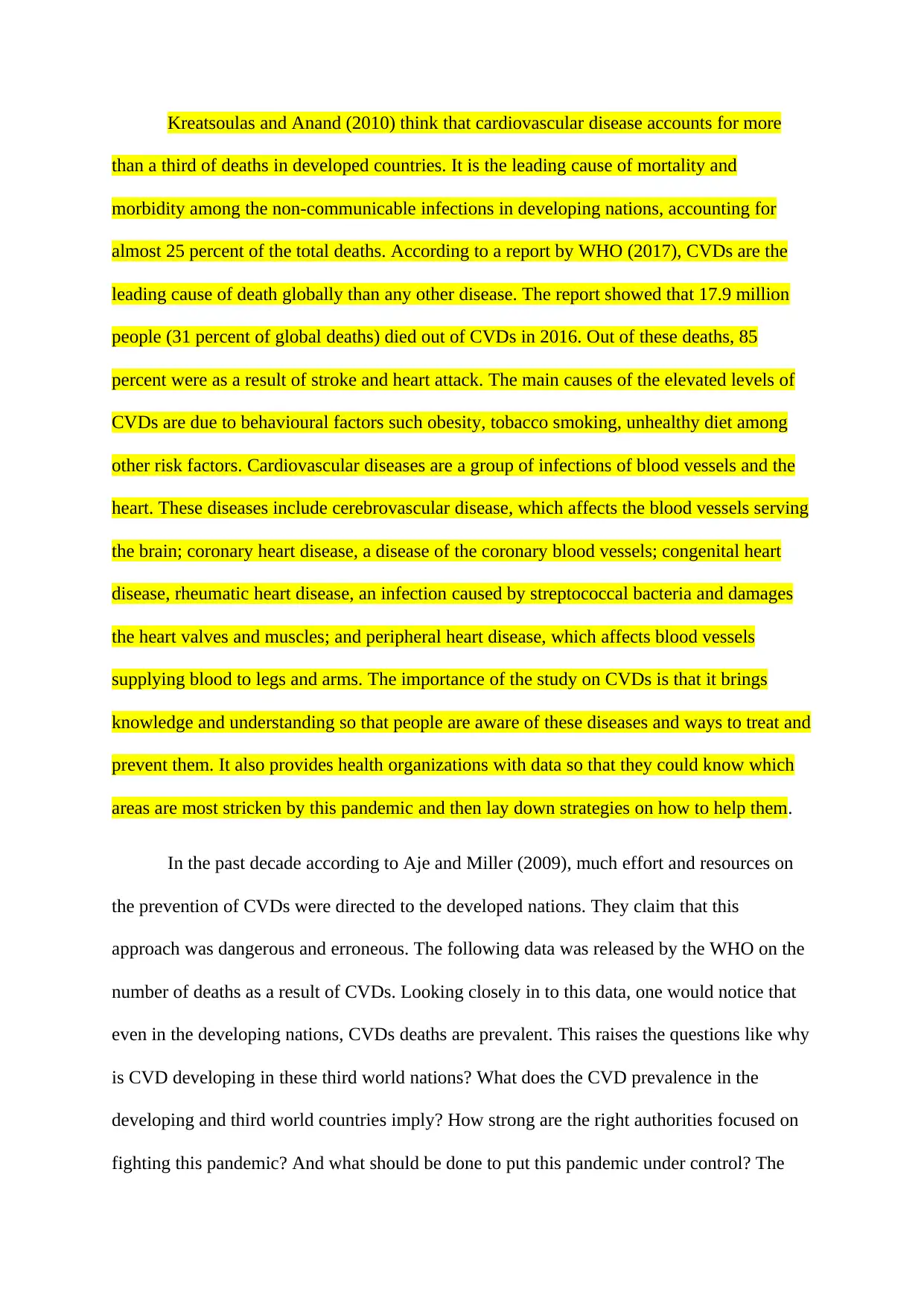
Kreatsoulas and Anand (2010) think that cardiovascular disease accounts for more
than a third of deaths in developed countries. It is the leading cause of mortality and
morbidity among the non-communicable infections in developing nations, accounting for
almost 25 percent of the total deaths. According to a report by WHO (2017), CVDs are the
leading cause of death globally than any other disease. The report showed that 17.9 million
people (31 percent of global deaths) died out of CVDs in 2016. Out of these deaths, 85
percent were as a result of stroke and heart attack. The main causes of the elevated levels of
CVDs are due to behavioural factors such obesity, tobacco smoking, unhealthy diet among
other risk factors. Cardiovascular diseases are a group of infections of blood vessels and the
heart. These diseases include cerebrovascular disease, which affects the blood vessels serving
the brain; coronary heart disease, a disease of the coronary blood vessels; congenital heart
disease, rheumatic heart disease, an infection caused by streptococcal bacteria and damages
the heart valves and muscles; and peripheral heart disease, which affects blood vessels
supplying blood to legs and arms. The importance of the study on CVDs is that it brings
knowledge and understanding so that people are aware of these diseases and ways to treat and
prevent them. It also provides health organizations with data so that they could know which
areas are most stricken by this pandemic and then lay down strategies on how to help them.
In the past decade according to Aje and Miller (2009), much effort and resources on
the prevention of CVDs were directed to the developed nations. They claim that this
approach was dangerous and erroneous. The following data was released by the WHO on the
number of deaths as a result of CVDs. Looking closely in to this data, one would notice that
even in the developing nations, CVDs deaths are prevalent. This raises the questions like why
is CVD developing in these third world nations? What does the CVD prevalence in the
developing and third world countries imply? How strong are the right authorities focused on
fighting this pandemic? And what should be done to put this pandemic under control? The
than a third of deaths in developed countries. It is the leading cause of mortality and
morbidity among the non-communicable infections in developing nations, accounting for
almost 25 percent of the total deaths. According to a report by WHO (2017), CVDs are the
leading cause of death globally than any other disease. The report showed that 17.9 million
people (31 percent of global deaths) died out of CVDs in 2016. Out of these deaths, 85
percent were as a result of stroke and heart attack. The main causes of the elevated levels of
CVDs are due to behavioural factors such obesity, tobacco smoking, unhealthy diet among
other risk factors. Cardiovascular diseases are a group of infections of blood vessels and the
heart. These diseases include cerebrovascular disease, which affects the blood vessels serving
the brain; coronary heart disease, a disease of the coronary blood vessels; congenital heart
disease, rheumatic heart disease, an infection caused by streptococcal bacteria and damages
the heart valves and muscles; and peripheral heart disease, which affects blood vessels
supplying blood to legs and arms. The importance of the study on CVDs is that it brings
knowledge and understanding so that people are aware of these diseases and ways to treat and
prevent them. It also provides health organizations with data so that they could know which
areas are most stricken by this pandemic and then lay down strategies on how to help them.
In the past decade according to Aje and Miller (2009), much effort and resources on
the prevention of CVDs were directed to the developed nations. They claim that this
approach was dangerous and erroneous. The following data was released by the WHO on the
number of deaths as a result of CVDs. Looking closely in to this data, one would notice that
even in the developing nations, CVDs deaths are prevalent. This raises the questions like why
is CVD developing in these third world nations? What does the CVD prevalence in the
developing and third world countries imply? How strong are the right authorities focused on
fighting this pandemic? And what should be done to put this pandemic under control? The
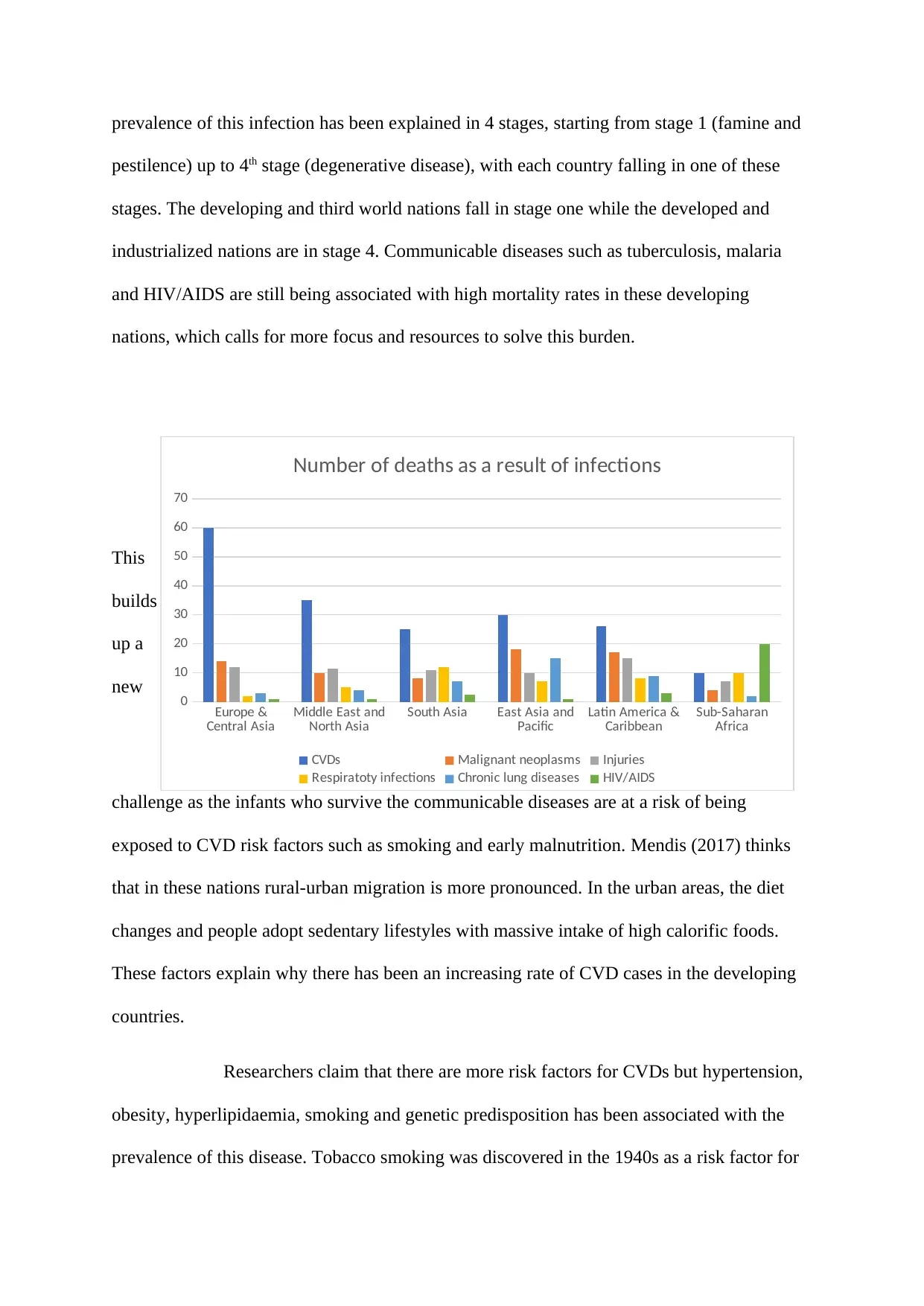
prevalence of this infection has been explained in 4 stages, starting from stage 1 (famine and
pestilence) up to 4th stage (degenerative disease), with each country falling in one of these
stages. The developing and third world nations fall in stage one while the developed and
industrialized nations are in stage 4. Communicable diseases such as tuberculosis, malaria
and HIV/AIDS are still being associated with high mortality rates in these developing
nations, which calls for more focus and resources to solve this burden.
This
builds
up a
new
challenge as the infants who survive the communicable diseases are at a risk of being
exposed to CVD risk factors such as smoking and early malnutrition. Mendis (2017) thinks
that in these nations rural-urban migration is more pronounced. In the urban areas, the diet
changes and people adopt sedentary lifestyles with massive intake of high calorific foods.
These factors explain why there has been an increasing rate of CVD cases in the developing
countries.
Researchers claim that there are more risk factors for CVDs but hypertension,
obesity, hyperlipidaemia, smoking and genetic predisposition has been associated with the
prevalence of this disease. Tobacco smoking was discovered in the 1940s as a risk factor for
Europe &
Central Asia Middle East and
North Asia South Asia East Asia and
Pacific Latin America &
Caribbean Sub-Saharan
Africa
0
10
20
30
40
50
60
70
Number of deaths as a result of infections
CVDs Malignant neoplasms Injuries
Respiratoty infections Chronic lung diseases HIV/AIDS
pestilence) up to 4th stage (degenerative disease), with each country falling in one of these
stages. The developing and third world nations fall in stage one while the developed and
industrialized nations are in stage 4. Communicable diseases such as tuberculosis, malaria
and HIV/AIDS are still being associated with high mortality rates in these developing
nations, which calls for more focus and resources to solve this burden.
This
builds
up a
new
challenge as the infants who survive the communicable diseases are at a risk of being
exposed to CVD risk factors such as smoking and early malnutrition. Mendis (2017) thinks
that in these nations rural-urban migration is more pronounced. In the urban areas, the diet
changes and people adopt sedentary lifestyles with massive intake of high calorific foods.
These factors explain why there has been an increasing rate of CVD cases in the developing
countries.
Researchers claim that there are more risk factors for CVDs but hypertension,
obesity, hyperlipidaemia, smoking and genetic predisposition has been associated with the
prevalence of this disease. Tobacco smoking was discovered in the 1940s as a risk factor for
Europe &
Central Asia Middle East and
North Asia South Asia East Asia and
Pacific Latin America &
Caribbean Sub-Saharan
Africa
0
10
20
30
40
50
60
70
Number of deaths as a result of infections
CVDs Malignant neoplasms Injuries
Respiratoty infections Chronic lung diseases HIV/AIDS
⊘ This is a preview!⊘
Do you want full access?
Subscribe today to unlock all pages.

Trusted by 1+ million students worldwide
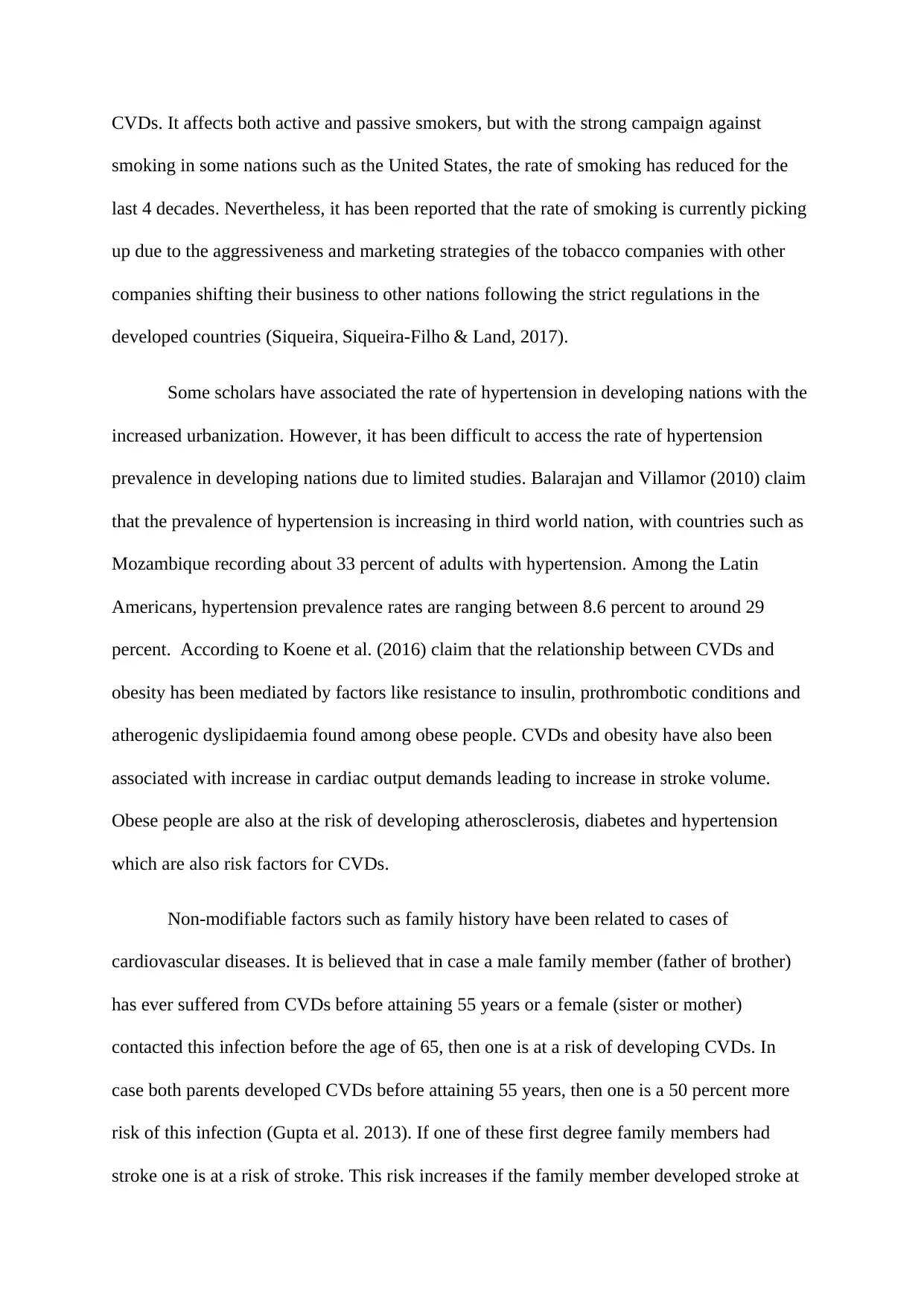
CVDs. It affects both active and passive smokers, but with the strong campaign against
smoking in some nations such as the United States, the rate of smoking has reduced for the
last 4 decades. Nevertheless, it has been reported that the rate of smoking is currently picking
up due to the aggressiveness and marketing strategies of the tobacco companies with other
companies shifting their business to other nations following the strict regulations in the
developed countries (Siqueira, Siqueira-Filho & Land, 2017).
Some scholars have associated the rate of hypertension in developing nations with the
increased urbanization. However, it has been difficult to access the rate of hypertension
prevalence in developing nations due to limited studies. Balarajan and Villamor (2010) claim
that the prevalence of hypertension is increasing in third world nation, with countries such as
Mozambique recording about 33 percent of adults with hypertension. Among the Latin
Americans, hypertension prevalence rates are ranging between 8.6 percent to around 29
percent. According to Koene et al. (2016) claim that the relationship between CVDs and
obesity has been mediated by factors like resistance to insulin, prothrombotic conditions and
atherogenic dyslipidaemia found among obese people. CVDs and obesity have also been
associated with increase in cardiac output demands leading to increase in stroke volume.
Obese people are also at the risk of developing atherosclerosis, diabetes and hypertension
which are also risk factors for CVDs.
Non-modifiable factors such as family history have been related to cases of
cardiovascular diseases. It is believed that in case a male family member (father of brother)
has ever suffered from CVDs before attaining 55 years or a female (sister or mother)
contacted this infection before the age of 65, then one is at a risk of developing CVDs. In
case both parents developed CVDs before attaining 55 years, then one is a 50 percent more
risk of this infection (Gupta et al. 2013). If one of these first degree family members had
stroke one is at a risk of stroke. This risk increases if the family member developed stroke at
smoking in some nations such as the United States, the rate of smoking has reduced for the
last 4 decades. Nevertheless, it has been reported that the rate of smoking is currently picking
up due to the aggressiveness and marketing strategies of the tobacco companies with other
companies shifting their business to other nations following the strict regulations in the
developed countries (Siqueira, Siqueira-Filho & Land, 2017).
Some scholars have associated the rate of hypertension in developing nations with the
increased urbanization. However, it has been difficult to access the rate of hypertension
prevalence in developing nations due to limited studies. Balarajan and Villamor (2010) claim
that the prevalence of hypertension is increasing in third world nation, with countries such as
Mozambique recording about 33 percent of adults with hypertension. Among the Latin
Americans, hypertension prevalence rates are ranging between 8.6 percent to around 29
percent. According to Koene et al. (2016) claim that the relationship between CVDs and
obesity has been mediated by factors like resistance to insulin, prothrombotic conditions and
atherogenic dyslipidaemia found among obese people. CVDs and obesity have also been
associated with increase in cardiac output demands leading to increase in stroke volume.
Obese people are also at the risk of developing atherosclerosis, diabetes and hypertension
which are also risk factors for CVDs.
Non-modifiable factors such as family history have been related to cases of
cardiovascular diseases. It is believed that in case a male family member (father of brother)
has ever suffered from CVDs before attaining 55 years or a female (sister or mother)
contacted this infection before the age of 65, then one is at a risk of developing CVDs. In
case both parents developed CVDs before attaining 55 years, then one is a 50 percent more
risk of this infection (Gupta et al. 2013). If one of these first degree family members had
stroke one is at a risk of stroke. This risk increases if the family member developed stroke at
Paraphrase This Document
Need a fresh take? Get an instant paraphrase of this document with our AI Paraphraser
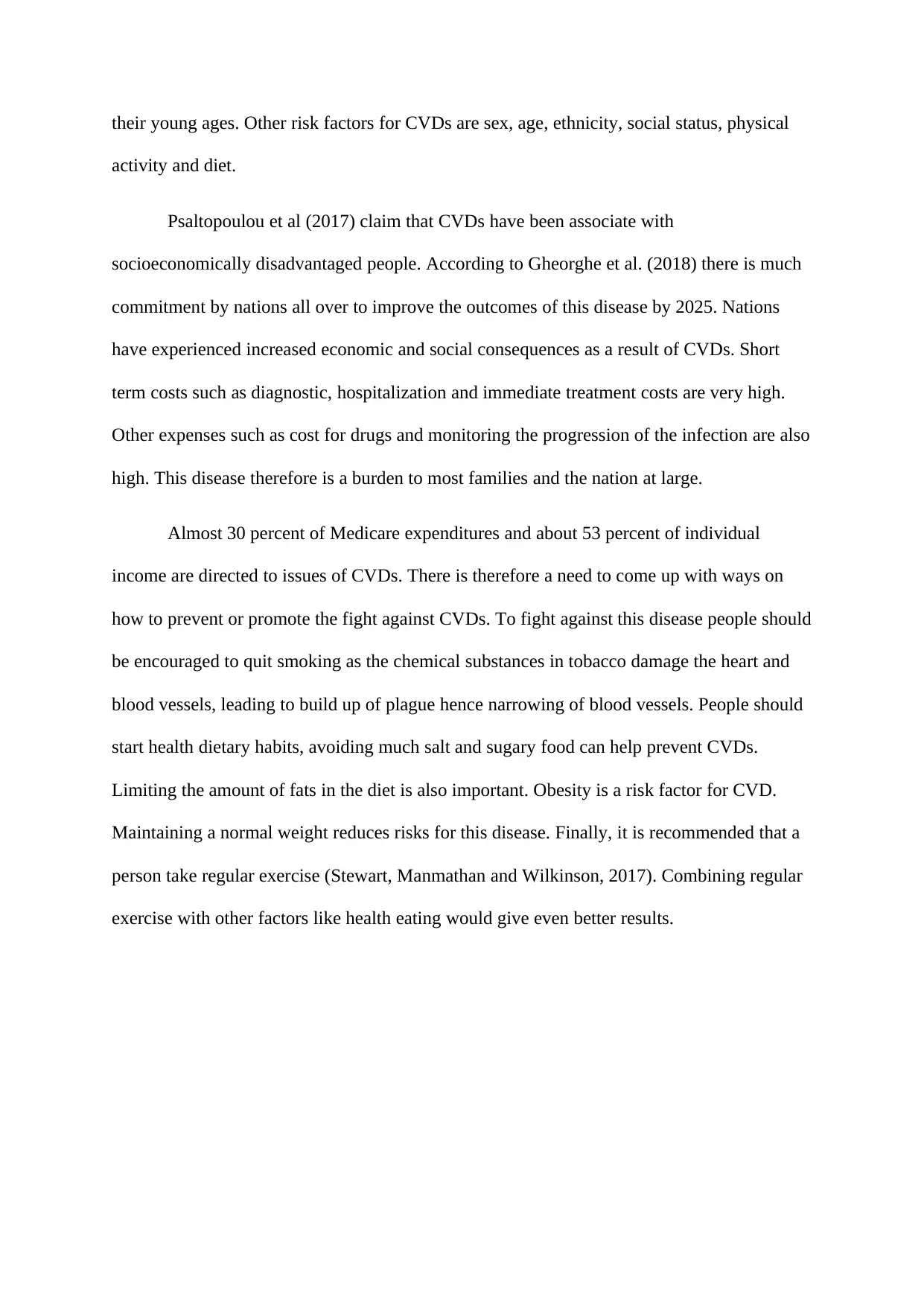
their young ages. Other risk factors for CVDs are sex, age, ethnicity, social status, physical
activity and diet.
Psaltopoulou et al (2017) claim that CVDs have been associate with
socioeconomically disadvantaged people. According to Gheorghe et al. (2018) there is much
commitment by nations all over to improve the outcomes of this disease by 2025. Nations
have experienced increased economic and social consequences as a result of CVDs. Short
term costs such as diagnostic, hospitalization and immediate treatment costs are very high.
Other expenses such as cost for drugs and monitoring the progression of the infection are also
high. This disease therefore is a burden to most families and the nation at large.
Almost 30 percent of Medicare expenditures and about 53 percent of individual
income are directed to issues of CVDs. There is therefore a need to come up with ways on
how to prevent or promote the fight against CVDs. To fight against this disease people should
be encouraged to quit smoking as the chemical substances in tobacco damage the heart and
blood vessels, leading to build up of plague hence narrowing of blood vessels. People should
start health dietary habits, avoiding much salt and sugary food can help prevent CVDs.
Limiting the amount of fats in the diet is also important. Obesity is a risk factor for CVD.
Maintaining a normal weight reduces risks for this disease. Finally, it is recommended that a
person take regular exercise (Stewart, Manmathan and Wilkinson, 2017). Combining regular
exercise with other factors like health eating would give even better results.
activity and diet.
Psaltopoulou et al (2017) claim that CVDs have been associate with
socioeconomically disadvantaged people. According to Gheorghe et al. (2018) there is much
commitment by nations all over to improve the outcomes of this disease by 2025. Nations
have experienced increased economic and social consequences as a result of CVDs. Short
term costs such as diagnostic, hospitalization and immediate treatment costs are very high.
Other expenses such as cost for drugs and monitoring the progression of the infection are also
high. This disease therefore is a burden to most families and the nation at large.
Almost 30 percent of Medicare expenditures and about 53 percent of individual
income are directed to issues of CVDs. There is therefore a need to come up with ways on
how to prevent or promote the fight against CVDs. To fight against this disease people should
be encouraged to quit smoking as the chemical substances in tobacco damage the heart and
blood vessels, leading to build up of plague hence narrowing of blood vessels. People should
start health dietary habits, avoiding much salt and sugary food can help prevent CVDs.
Limiting the amount of fats in the diet is also important. Obesity is a risk factor for CVD.
Maintaining a normal weight reduces risks for this disease. Finally, it is recommended that a
person take regular exercise (Stewart, Manmathan and Wilkinson, 2017). Combining regular
exercise with other factors like health eating would give even better results.
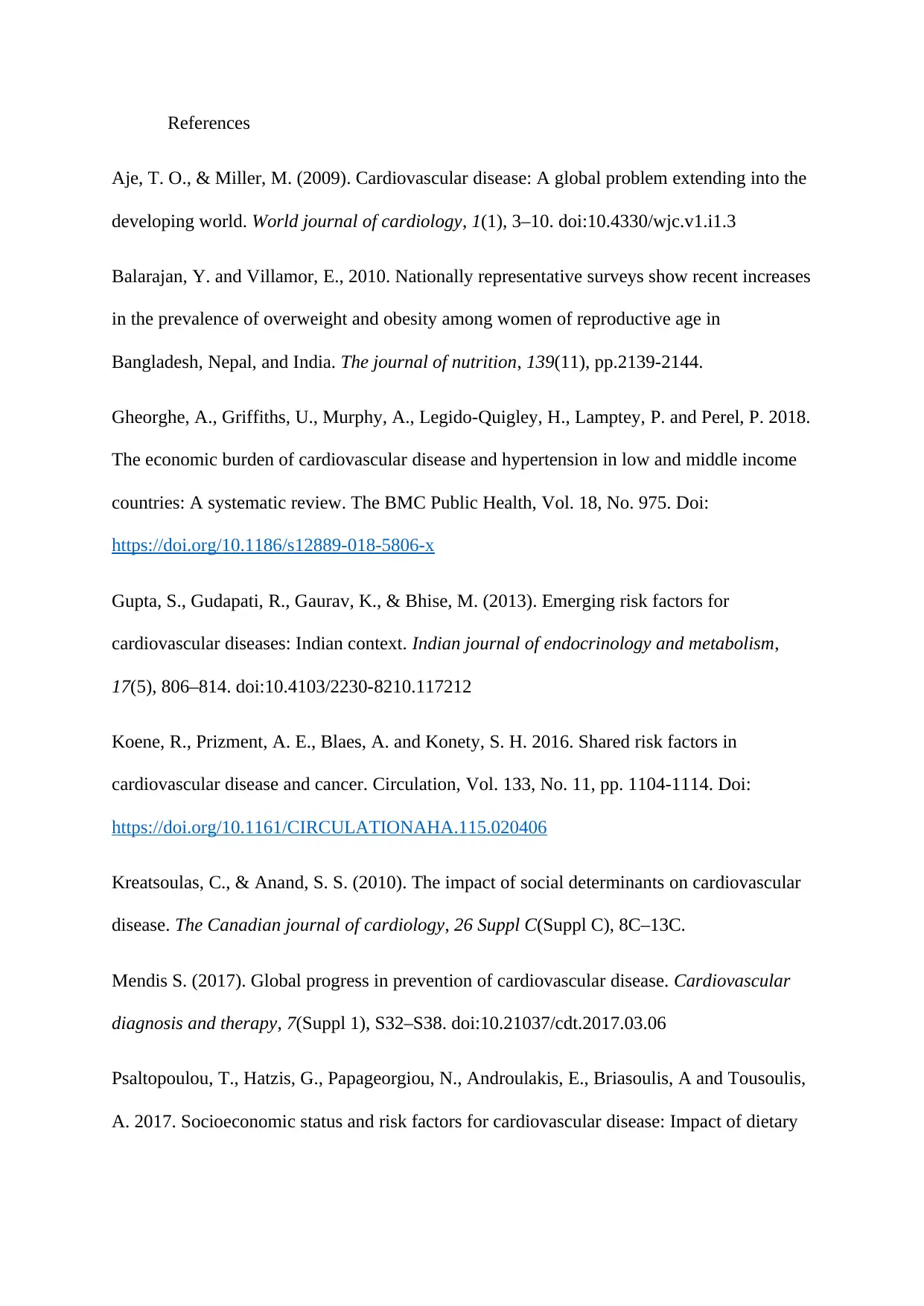
References
Aje, T. O., & Miller, M. (2009). Cardiovascular disease: A global problem extending into the
developing world. World journal of cardiology, 1(1), 3–10. doi:10.4330/wjc.v1.i1.3
Balarajan, Y. and Villamor, E., 2010. Nationally representative surveys show recent increases
in the prevalence of overweight and obesity among women of reproductive age in
Bangladesh, Nepal, and India. The journal of nutrition, 139(11), pp.2139-2144.
Gheorghe, A., Griffiths, U., Murphy, A., Legido-Quigley, H., Lamptey, P. and Perel, P. 2018.
The economic burden of cardiovascular disease and hypertension in low and middle income
countries: A systematic review. The BMC Public Health, Vol. 18, No. 975. Doi:
https://doi.org/10.1186/s12889-018-5806-x
Gupta, S., Gudapati, R., Gaurav, K., & Bhise, M. (2013). Emerging risk factors for
cardiovascular diseases: Indian context. Indian journal of endocrinology and metabolism,
17(5), 806–814. doi:10.4103/2230-8210.117212
Koene, R., Prizment, A. E., Blaes, A. and Konety, S. H. 2016. Shared risk factors in
cardiovascular disease and cancer. Circulation, Vol. 133, No. 11, pp. 1104-1114. Doi:
https://doi.org/10.1161/CIRCULATIONAHA.115.020406
Kreatsoulas, C., & Anand, S. S. (2010). The impact of social determinants on cardiovascular
disease. The Canadian journal of cardiology, 26 Suppl C(Suppl C), 8C–13C.
Mendis S. (2017). Global progress in prevention of cardiovascular disease. Cardiovascular
diagnosis and therapy, 7(Suppl 1), S32–S38. doi:10.21037/cdt.2017.03.06
Psaltopoulou, T., Hatzis, G., Papageorgiou, N., Androulakis, E., Briasoulis, A and Tousoulis,
A. 2017. Socioeconomic status and risk factors for cardiovascular disease: Impact of dietary
Aje, T. O., & Miller, M. (2009). Cardiovascular disease: A global problem extending into the
developing world. World journal of cardiology, 1(1), 3–10. doi:10.4330/wjc.v1.i1.3
Balarajan, Y. and Villamor, E., 2010. Nationally representative surveys show recent increases
in the prevalence of overweight and obesity among women of reproductive age in
Bangladesh, Nepal, and India. The journal of nutrition, 139(11), pp.2139-2144.
Gheorghe, A., Griffiths, U., Murphy, A., Legido-Quigley, H., Lamptey, P. and Perel, P. 2018.
The economic burden of cardiovascular disease and hypertension in low and middle income
countries: A systematic review. The BMC Public Health, Vol. 18, No. 975. Doi:
https://doi.org/10.1186/s12889-018-5806-x
Gupta, S., Gudapati, R., Gaurav, K., & Bhise, M. (2013). Emerging risk factors for
cardiovascular diseases: Indian context. Indian journal of endocrinology and metabolism,
17(5), 806–814. doi:10.4103/2230-8210.117212
Koene, R., Prizment, A. E., Blaes, A. and Konety, S. H. 2016. Shared risk factors in
cardiovascular disease and cancer. Circulation, Vol. 133, No. 11, pp. 1104-1114. Doi:
https://doi.org/10.1161/CIRCULATIONAHA.115.020406
Kreatsoulas, C., & Anand, S. S. (2010). The impact of social determinants on cardiovascular
disease. The Canadian journal of cardiology, 26 Suppl C(Suppl C), 8C–13C.
Mendis S. (2017). Global progress in prevention of cardiovascular disease. Cardiovascular
diagnosis and therapy, 7(Suppl 1), S32–S38. doi:10.21037/cdt.2017.03.06
Psaltopoulou, T., Hatzis, G., Papageorgiou, N., Androulakis, E., Briasoulis, A and Tousoulis,
A. 2017. Socioeconomic status and risk factors for cardiovascular disease: Impact of dietary
⊘ This is a preview!⊘
Do you want full access?
Subscribe today to unlock all pages.

Trusted by 1+ million students worldwide
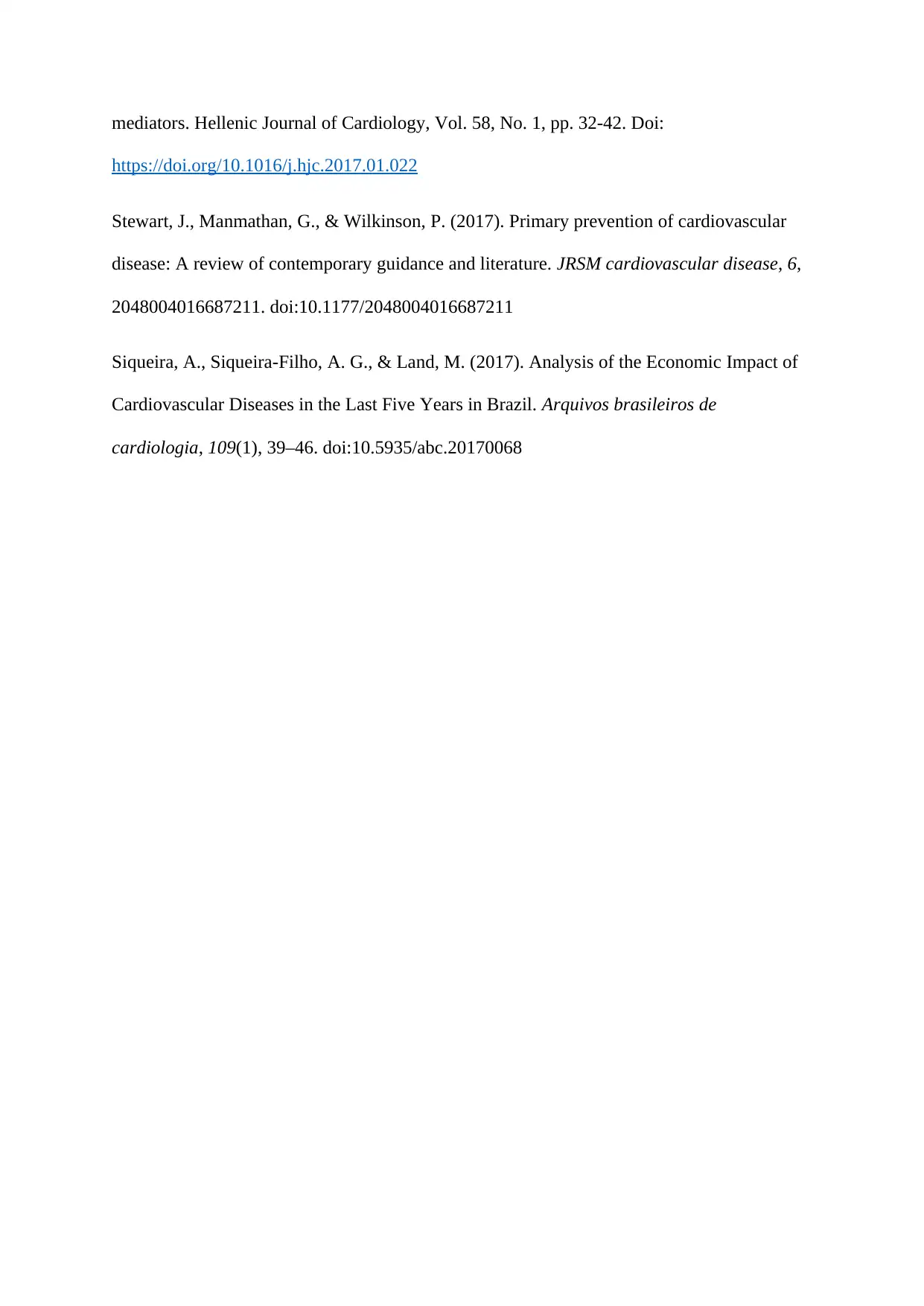
mediators. Hellenic Journal of Cardiology, Vol. 58, No. 1, pp. 32-42. Doi:
https://doi.org/10.1016/j.hjc.2017.01.022
Stewart, J., Manmathan, G., & Wilkinson, P. (2017). Primary prevention of cardiovascular
disease: A review of contemporary guidance and literature. JRSM cardiovascular disease, 6,
2048004016687211. doi:10.1177/2048004016687211
Siqueira, A., Siqueira-Filho, A. G., & Land, M. (2017). Analysis of the Economic Impact of
Cardiovascular Diseases in the Last Five Years in Brazil. Arquivos brasileiros de
cardiologia, 109(1), 39–46. doi:10.5935/abc.20170068
https://doi.org/10.1016/j.hjc.2017.01.022
Stewart, J., Manmathan, G., & Wilkinson, P. (2017). Primary prevention of cardiovascular
disease: A review of contemporary guidance and literature. JRSM cardiovascular disease, 6,
2048004016687211. doi:10.1177/2048004016687211
Siqueira, A., Siqueira-Filho, A. G., & Land, M. (2017). Analysis of the Economic Impact of
Cardiovascular Diseases in the Last Five Years in Brazil. Arquivos brasileiros de
cardiologia, 109(1), 39–46. doi:10.5935/abc.20170068
1 out of 7
Related Documents
Your All-in-One AI-Powered Toolkit for Academic Success.
+13062052269
info@desklib.com
Available 24*7 on WhatsApp / Email
![[object Object]](/_next/static/media/star-bottom.7253800d.svg)
Unlock your academic potential
Copyright © 2020–2025 A2Z Services. All Rights Reserved. Developed and managed by ZUCOL.





